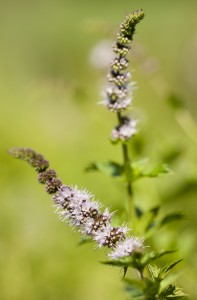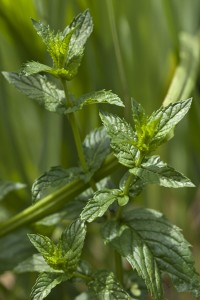“M” is for Mint
Posted in Gardening Tips on August 19 2014, by Sonia Uyterhoeven

In Greek mythology, the goddess Persephone suspected her husband Hades, god of the underworld, of having a tryst with a nymph named Minthe. In a jealous rage, she transformed the lovely nymph into a perennial herb. Hades, unable to counteract his wife’s spell, bestowed Minthe with a sweet smell so that she would continue to delight those who came in contact with her.
Clearly, the aromatic qualities of mint are legendary. Through the centuries, mint has played an important role in many cultures, from the Greeks who rubbed mint leaves on their tables to welcome guests, to India, where it was strewn around temples and homes to clean the air. In the middle east, mint tea is often brought out to greet friends in the home.
Unlike many herbs that prefer sunny, dry spots, mints prefer moist soil in part shade/sun. As many of us know too well from experience, however, they are highly adaptable plants—and that’s putting it mildly. They grow in a wide range of conditions and are only too happy to expand their territory once they are planted in the ground. When I was a kid, my mother planted peppermint behind the vegetable garden; years later, the vegetable garden is gone, but the mint still thrives.
One trick to keeping the mint in bounds is to plant it in a large, bottomless container that you sink into the ground. I generally grow mint in decorative containers where I am not bothered by the prospect of colonizing impulses, and keep it close by so I can cut off sprigs for iced teas.
Don’t be shy with mint, either. The reasons for growing it outnumber the drawbacks, and they make for more than a refreshing addition to summer beverages. Mints are also a wonderful pest repellant. City dwellers can plant members of the mint family around residential buildings to deter rats. Mint-scented garbage bags have been on the market for over a decade now, touted as a first-rate rodent repellant.
Deer and rabbits will leave mint plants alone due to their aromatic qualities, too. According to companion planting lore, they partner well with cabbages, broccoli, kale, and cauliflower, not only improving the flavor of their neighbor but also deterring flea beetles and white cabbage butterflies.
 The most common mints on the market are peppermint (Mentha × piperita), spearmint (Mentha spicata), and apple mint (Mentha suaveolens). Peppermint has a strong, spicy flavor, while spearmint tends to be sweeter. People who discover that they have an intolerance for peppermint (it doesn’t agree with everyone) should give spearmint it a try.
The most common mints on the market are peppermint (Mentha × piperita), spearmint (Mentha spicata), and apple mint (Mentha suaveolens). Peppermint has a strong, spicy flavor, while spearmint tends to be sweeter. People who discover that they have an intolerance for peppermint (it doesn’t agree with everyone) should give spearmint it a try.
Apple mint has soft green foliage and a pleasant apple fragrance. It tolerates dry conditions better than most mints and grows well indoors. The mild, slightly fruity leaves are generally candied or used in fruit salads.
As mentioned, these mints work well when used to make tea and combine nicely with carrots, peas, and potatoes to lend a refreshing flavor to any dish. Toss them onto pasta at the last minute as you would basil, or indulge and dip the mint leaves in chocolate, then let them harden in the refrigerator until you’re ready to dress up a dessert dish.
Other mints that are worth trying are chocolate mint (Mentha × piperita f. citrata ‘Chocolate’), grapefruit mint (Mentha suaveolens × piperita), orange mint (Mentha × piperita f. citrata), pineapple mint (Mentha suaveolens ‘Variegata’), and curly mint (Mentha spicata var. crispa). Whatever you choose to grow, you should have a refreshing addition to your summer menu to last you and then some.

